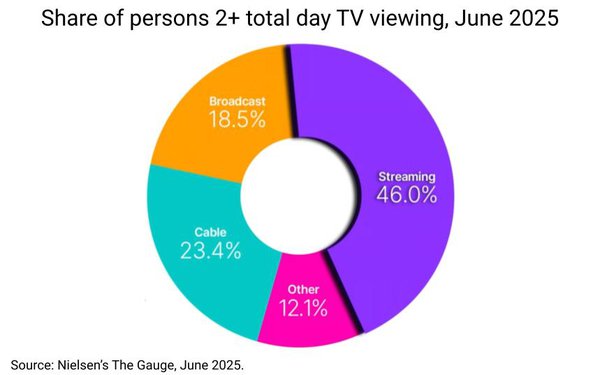
June streaming
television results strongly benefited from leading premium streaming service Netflix -- which leaped 13.5% in viewing versus May to a 8.5% viewing share, according to Nielsen’s Total
TV/Streaming Snapshot.
This increase was largely driven by the most-viewed original streaming TV series in the month -- Netflix’s “Ginny & Georgia,” with
a dominant 8.7 billion viewing minutes.
Netflix's results were so strong that the subscription video platform accounted for 42% of streaming’s total monthly gain.
Year-over-year -- with more competition from other streaming platforms (and YouTube) compared to 11 major streamers -- Netflix is basically flat versus the same month a year ago (8.4%)
Looking at overall streaming viewing from all platforms, usage grew to a 46% share -- a 5.4% rise from May. Looking year-over-year, all major streaming platforms are 14% higher (versus a
40.3% share in May 2024).
advertisement
advertisement
Traditionally, summer viewing is lower. Broadcast viewing declined 10% to an 18.5% share (versus a 20.5% share over the same period in 2024) with cable TV
down 14% to 23.4% (from 27.2% share).
Collectively, legacy TV platforms share (broadcast and cable) are now at a 41.9% share versus 47.7% a year ago -- a decline of 12%
compared to a year ago.
The NBA was a positive factor in June’s broadcast results. A closely competitive, full seven-game series on ABC helped boost sports on broadcast
TV by 17% over May’s results.
Cable also benefited from the NBA's earlier Conference Finals airings on ESPN and TNT. In addition, cable TV news viewing climbed 12% versus
May.
These results helped the cable TV network remain essentially flat with the month of May.
Peacock posted a 13.4% gain in the month --- the second-highest among all
streamers. The NBC streamer is also 25% higher in share (to 1.5%) versus a year ago, thanks to a new season of its popular “Love Island USA” debuted pulling 4.4 million viewing
minutes.
Leading platform YouTube continued its overall streaming leadership with a 12.8% share -- up 29% versus the year before, when it was 9.9%.
YouTube had a 2.5% share in
May 2025.
